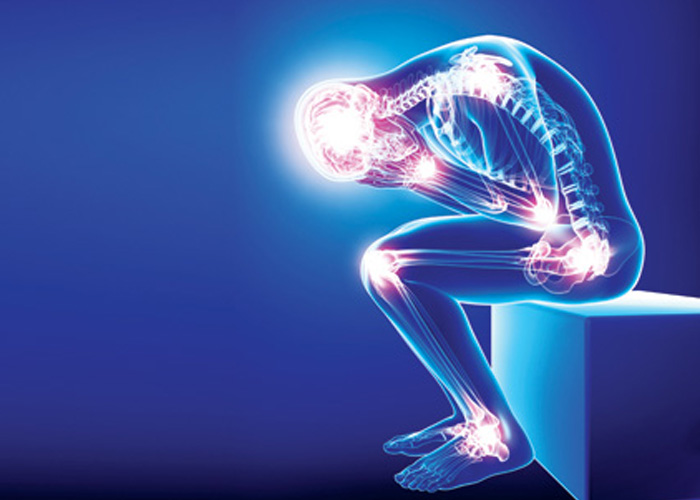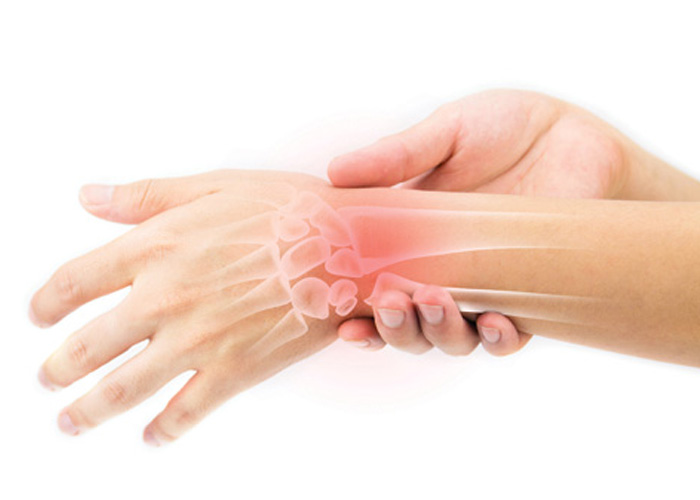Targeting pain
In OTC
Follow this topic
Bookmark
Record learning outcomes
When pain strikes most people reach for a pack of oral analgesics – but there are times when topical pain relief may be more appropriate. This feature explores how pharmacists can support people with musculoskeletal pain using topical pain relief products

Learning objectives
After reading this feature you should be able to:
• Understand the burden of musculoskeletal pain and its impact on sufferers
• Explain the evidence supporting the efficacy and safety of topical analgesics
• Provide self-care and lifestyle strategies for people with chronic pain.
An estimated 10 million people across the UK currently suffer with a musculoskeletal condition such as arthritis or back pain – and numbers are continuing to rise, fuelled by an ageing population and increasing levels of obesity and physical inactivity.1 As a result, musculoskeletal conditions now rank as the leading cause of disability in the country.2
Arthritis Research UK describes good musculoskeletal health as “the muscles, joints and bones working well together without pain”. Musculoskeletal health is a lynchpin of overall health and wellbeing, and the impact of musculoskeletal conditions can be considerable – leading to pain, stiffness, loss of mobility and reduced dexterity.
“Musculoskeletal conditions can be painful and distressing, causing a loss of confidence, dignity and independence,” says Kevin Fenton, director of health and wellbeing at Public Health England. “In some cases it can have quite severe consequences to the life chances of an individual through the loss of work, and dependence on the state, family and friends.”
Aside from the direct pain and disability they cause, musculoskeletal conditions are additionally linked to a host of other adverse health conditions. Patients with osteoarthritis – the most common form of musculoskeletal disease – are at increased risk of cardiovascular disease and premature mortality.2
A reduction in life expectancy is also seen in inflammatory musculoskeletal conditions such as rheumatoid arthritis and is an important consequence of falls and fragility fractures in older patients.2
Musculoskeletal conditions also have a significant impact on mental health, with the intertwined relationship between pain and anxiety/depression proving hugely complex and reciprocal. Depression is four times more common for patients with chronic pain and, conversely, is also an independent risk factor for developing back pain.2 Similarly, anxiety is often seen in sufferers of osteoarthritis, with around two-thirds reporting symptoms of depression when their pain is uncontrolled.2
In its report, Musculoskeletal Health: A Public Health Approach, Arthritis Research UK describes how psychological distress and depression can worsen pain, creating a vicious cycle where ever-worsening pain and low mood lead to social withdrawal and a progressive reduction in quality of life. As Liam O’Toole, chief executive of Arthritis Research UK, explains: “The limitations of arthritis and musculoskeletal pain make simple activities a daily struggle. From going to work and interacting with family, to socialising with friends or popping to the shops…On top of the effects on the individual, there is a major impact on health and care services and the economy.”
Musculoskeletal conditions now rank as the leading cause of disability in the UK
What causes musculoskeletal pain?
The aetiology of musculoskeletal pain is complex. Good musculoskeletal health relies on effective interaction between a number of the body’s organs and systems. Joints and the spine must be stable and supple to support the body and perform a variety of different movements, while muscles must be strong enough to provide the underlying power. Also bones must be robust and relatively unbreakable. A healthy nervous system is kingmaker for the entire system, co-ordinating the activity of the spine, bones, muscles and joints, and instilling balance.2
When any part of this interlinked system breaks down, musculoskeletal conditions can develop. The two most common causes of musculoskeletal pain are osteoarthritis and back problems.
Osteoarthritis is a painful wear and tear arthritis resulting from degeneration of the cartilage that provides a protective cushion between bones. This causes the joints to become painful, swollen and difficult to move. Knees, hips, hands, spine and the big toes are most frequently affected. Osteoarthritis affects nearly 9 million people in the UK, of whom three-quarters report some form of constant pain caused by their condition.2,3
Like osteoarthritis, back pain is a common musculoskeletal ailment that occurs more frequently with rising age. Figures suggest that one in six adults aged over 25 years has suffered from back pain lasting three months or more in the previous year.2 Other important musculoskeletal conditions include osteoporosis, which is a leading cause of fragility fractures, and inflammatory autoimmune-related joint disorders.

Role of topical analgesics
The top priority for any customer suffering from a musculoskeletal condition is effective pain relief. With topical analgesics now driving growth in the OTC pain relief category and continued questions over the safety of long-term oral painkiller use, could now be the time to ‘think topical’ when it comes to musculoskeletal pain relief?
Topical analgesics are applied externally to the skin – either by rubbing or via patch or plaster formulations – and exert their effects locally. Effective skin penetration is key to their efficacy and certain products may boast advantages over others. The balance between lipid and aqueous solubility must be optimised and the delivery formulation is also critical. Creams appear generally less effective than sprays or gels and state-of-the art formulations such as micro-emulsions also appear to offer certain key advantages.4
Once through the skin barrier, topical non-steroidal anti-inflammatory drugs (NSAIDs) – like their oral cousins – exert their therapeutic effects by inhibiting the cyclo-oxygenase (COX)-2 enzyme, which is a key driver of prostaglandin production. It has been confirmed that topically applied NSAIDs reach tissue levels high enough to block COX-2. Their main effect is likely to be localised – reducing symptoms arising from periarticular and intracapsular structures in the joints and skeletal muscle.4
Although not currently endorsed for back pain, osteoarthritis guidance from the National Institute for Health and Care Excellence (NICE) already recommends the use of topical NSAIDs or paracetamol ahead of oral NSAIDs, COX-2 inhibitors or opioids – especially when joint pain affects the hands or knees. NICE also suggests topical capsaicin as an adjunctive treatment option for knee or hand osteoarthritis.
Topical NSAID gels, creams and ointments have shown improved efficacy compared with placebo in a number of short-term clinical studies of patients with joint pain, particularly knee osteoarthritis. A recent Cochrane review concluded that, “there is a body of reliable evidence about the efficacy of topical analgesics in different types of acute and chronic pain”.4
For acute musculoskeletal pain such as sprains and strains, topical NSAIDs – specifically diclofenac, ketoprofen or piroxicam gels or diclofenac plasters – provided at least 50 per cent pain relief over about a week in around 20-50 per cent of patients.
For hand and knee osteoarthritis, topical diclofenac and ketoprofen reduced pain by at least 50 per cent over six to 12 weeks in around 10-20 per cent of people, with numbers needed to treat (NNT) ranging from five to 10.
Although NNTs were higher in the chronic pain domain, the Cochrane authors noted that, “this still indicates a small proportion of people had good pain relief with topical NSAIDs”. In contrast, there was insufficient evidence to support the use of topical salicylate, low-dose capsaicin, clonidine or lidocaine.4
Although the efficacy evidence may be relatively modest, where topical analgesics really come into their own is their safety profile. Topicals exert their effects close to the site of application, so there is little systemic drug uptake or wider distribution throughout the body. Plasma concentrations of active drug after topical administration are typically only a fraction – less than 5 per cent – of levels found after oral dosing.4
As a result, topical NSAIDs are associated with a lower risk of systemic adverse events compared to their oral counterparts and have generally proven better tolerated in patients with musculoskeletal pain.6 Cochrane found that systemic and local adverse events with topical NSAIDs were equivalent to placebo in acute pain.
Although there were more local adverse events with topical diclofenac in chronic pain conditions, the number needed to harm (NNH) was high (16) and there was no evidence of a similar increase with topical ketoprofen. Serious side-effects with topical NSAIDs were rare across the board but it is important to note that topical low-concentration capsaicin caused local side-effects such as rash or itching in around 40 per cent of treated patients.
Given that many musculoskeletal conditions are chronic, the risk/benefit profile of extended analgesic use for prolonged periods of time is a key issue. Topical NSAID analgesics may therefore be preferred for their superior safety profile versus their oral counterparts – particularly in older customers or those with other underlying health conditions.
Pharmacy teams should remain alert to the reality that, despite their widespread use, oral NSAIDs carry a number of serious cautions/contraindications and potentially significant drug-drug interactions. Recent reports in the media have shone a spotlight on the safety of oral painkillers. In contrast, we know that the risk of upper gastrointestinal (GI) bleeding is low even with chronic use of topical NSAIDs.4 A recent systematic review and meta- analysis also identified no serious GI or renal adverse events with topical NSAID use either in clinical trials or the general population.7
Following NICE advice, topical analgesics should therefore be recommended first-line for joint pain due to osteoarthritis and can also be trialled in other musculoskeletal conditions. Customers should be counselled to continue to apply topical treatments for up to two weeks to reap maximum effects. However, as the Cochrane authors warn, “failure to achieve good pain relief should not be acceptable because it is likely that failure with any one drug could be reversed with another”.4
Pharmacy staff should therefore be on hand to suggest alternative analgesic options for customers who continue to suffer musculoskeletal pain – be it offering a different topical formulation or escalating to an oral equivalent.
Key facts
• Topical NSAID analgesics are recommended first-line for several types of musculoskeletal pain
• Several treatment pathways are available including best practice on managing chronic peripheral joint pain
• Physical activity and weight control are cornerstones of the non-pharmacological management of musculoskeletal pain
General management advice
Beyond pharmacotherapy, core treatments for osteoarthritis recommended by NICE can be provided in the pharmacy setting and are suitable for most patients with musculoskeletal pain irrespective of their age, comorbidity, pain levels or disability.8,9 These include:
- Patient information (both verbal and written) to help patients understand the nature, causes and possible consequences of their musculoskeletal condition
- Aerobic and local strengthening exercises. Patients should be advised to maintain rather than avoid physical activity and encouraged that ‘any exercise is better than none’
- Support for optimal weight management
- Advice on appropriate footwear, which should consist of thick but soft soles, no raised heels, a broad forefoot and deep soft uppers
- Advice on adjunctive treatments including supports and braces, TENS and thermotherapy (heat or ice).
For patients with back pain, NICE recommends providing advice tailored to patients’ needs and capabilities, including information on the nature of low back pain and encouragement to continue with their normal activities. Exercise programmes – such as biomechanical, aerobic or mind-body activities – may be beneficial for treating specific episodes or flare-ups of low back pain. Manual therapies such as spinal manipulation or soft tissue massage can also be a useful part of the overall treatment package. However, acupuncture or electrotherapies such as TENS are not recommended for treating back pain.9

Pharmacy’s key part to play
As the customer-facing frontline of primary care, community pharmacy teams can fulfil a vital role in optimising the management of musculoskeletal pain, both with topical analgesics and self-management advice.
To help facilitate this, the Royal Pharmaceutical Society has recently produced a treatment pathway that includes best practice recommendations on the management of chronic peripheral joint pain in the community pharmacy setting. This pathway sets out key steps from patient-centred consultation and information gathering to initial and long-term management, support and referral.
In line with NICE advice, the RPS pathway also recommends topical NSAIDs as first-line pharmacological therapy for joint pain, noting that “for patients with hand and knee pain, topical NSAIDs may be just as effective as oral NSAIDs and, apart from local skin reactions, are extremely safe”.8
The whole pharmacy team can help identify people with musculoskeletal conditions who might otherwise slip through the cracks. According to an Arthritis Research UK report, six out of 10 people with arthritis don’t believe their condition is high priority for the NHS, leading many to disguise their musculoskeletal pain and its impact.2
The RPS pathway suggests important routes for pinpointing potential musculoskeletal pain sufferers in a pharmacy setting, such as medication reviews, self-selected OTC pain relief products and customers requesting analgesic advice at the counter.
On an individual patient level, pharmacists can help ensure musculoskeletal conditions are managed within a broader health context – rather than a singular painful complaint – by considering key issues such as comorbidities and concomitant medications, as well as mental health implications. This is particularly important given that musculoskeletal conditions are often found in people with other long-term health problems. By 65 years of age, nearly half of people with a heart, lung or mental health disorder will also suffer from a musculoskeletal complaint – and this number is projected to grow.1,2
Depression is four times more common for patients with chronic pain
Safeguarding the future
Beyond the relief of pain in the here-and-now, pharmacy teams can invoke their credentials as healthy living ambassadors to set customers on the path to positive lifestyle changes that will improve musculoskeletal conditions over the long-term.
As Arthritis Research UK (now Versus Arthritis) points out: “For people with arthritis and musculoskeletal conditions, perceptions must change that nothing can be done. People should be empowered with knowledge about keeping their own bones, joints and muscles healthy, and supported to make changes to achieve this.”2
Unsurprisingly, many of the interventions that boost general health are also proven to have a beneficial effect on musculoskeletal pain in the round. Top of the list are physical activity and weight reduction, which are key to improving the symptoms of all musculoskeletal conditions. Maintaining healthy levels of physical activity improves overall musculoskeletal health and is proven effective in both primary and secondary prevention of painful musculoskeletal conditions.
Exercise improves the structure and health of the cartilage, while boosting the strength and mass of muscles that acts to stabilise joints. It also helps increase peak bone strength, slowing the speed of subsequent decline with ageing.
Other key areas for pharmacy-led interventions are smoking and nutrition. In addition to the catalogue of wider adverse health effects, smoking increases the risk of rheumatoid arthritis, chronic back pain and fibromyalgia. Although the biological mechanisms are unclear, people who smoke tend to report more extensive and worse musculoskeletal pain than non-smokers.2
Nutrition is also important to overall musculoskeletal health – particularly intake of protein and vitamin D. Insufficient protein consumption can accelerate loss of muscle mass that occurs naturally with ageing, increasing the risk of falls. Vitamin D is also critical as low levels are linked to impaired muscular strength and weaker bones.
According to the Arthritis Research UK report, “nutritional supplements such as vitamin D or protein may lead to improved musculoskeletal health including fewer falls for some older people, particularly when combined with exercise”. The report expounds a new way of thinking in which everyone at any age is encouraged to do something to improve and maintain their musculoskeletal health. The aim is to shift the focus away from simply treating musculoskeletal disease to promoting lifelong musculoskeletal health.
As Professor Fenton of Public Health England explains: “We need to focus our collaborative efforts on changing the burden of a musculoskeletal tide and act early to prevent, detect, treat and target public health interventions across the life course.”2
Moving forward, pharmacy efforts therefore remain vital and must continue to target the major risk factors for musculoskeletal ill-health – obesity, physical inactivity, poor nutrition and smoking.
References
- Arthritis Research UK. Musculoskeletal Conditions and Multimorbidity
- Arthritis Research UK. Musculoskeletal Health. A Public Health Approach
- NHS
- Cochrane Systematic Reviews Derry S et al. Topical analgesics for acute and chronic pain in adults – an overview of Cochrane reviews.
- NICE. Osteoarthritis: care and management. Clinical guideline CG177. Published February 2014
- NICE Clinical Knowledge Summaries. Osteoarthritis. Updated June 2018
- Br J Sports Med Zeng C et al. Relative efficacy and safety of topical non-steroidal anti-inflammatory drugs for osteoarthritis: a systematic review and network meta analysis of randomised controlled trials and observational studies
- The Pharmaceutical Journal Cottrell E et al. Appropriate community pharmacy management and referral of patients with chronic peripheral joint pain
- NICE. Low back pain and sciatica in over 16s: assessment and management. NICE guideline NG59. Published November 2016.
